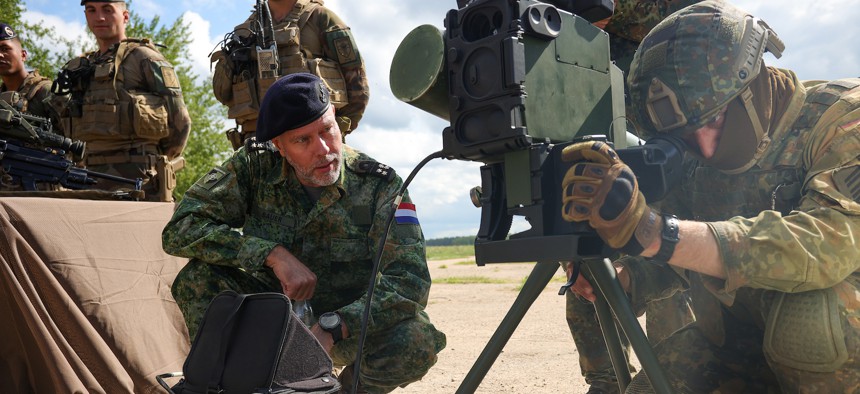
Adm. Rob Bauer (left), chair of the military committee of NATO, inspects equipment of members of the German-French Brigade on July 10, 2023 at the Gaiziunai military training area in Gaiziunai, Lithuania. Tim Ireland / Getty Images
Defense Business Brief: NATO’s 2% scorecard; Exports boom; LHX mulls divestiture; and a little more.
Nine years ago, NATO members endorsed a guideline of spending 2 percent of each country’s gross domestic product on defense within a decade. With a year left on that timeline—and as alliance heads of state meet in Vilnius this week—how are they doing?
The Defence Investment Pledge emerged from the 2014 NATO Summit in Newport, Wales, arguably the most important since the end of the Cold War. Leaders wanted to make a statement, not just about standing up to Russia, which had recently annexed Crimea, but also about fighting ISIS in the Middle East.
At the time, only the United States, Greece, and the United Kingdom met that benchmark, depending on how you tally annual spending. (More on that below.) The alliance is one member larger since Finland’s admission in April. Sweden has also applied to join, but Turkey is blocking its entrance.
Now some nuance: What NATO considers “defense spending” differs from what others might consider spending on defense. For instance, the alliance’s metrics include items like military pensions for some nations, thus making their annual expenditures appear higher than others.
So we asked Dan Darling at Forecast International, a defense data and consulting firm owned by Defense One parent company GovExec, for some help making sense of the numbers. Here are the big takeaways:
- Today, 10 of the 31 member nations meet the 2 percent goal, meaning 21 nations don’t meet the benchmark. Belgium, Canada, Luxembourg, and Spain all spend less than 1 percent of their GDP on defense. Then there’s Iceland, which doesn’t have a military.
- The U.S. spends the most—both in total, $851 billion in 2023, and as a share of GDP.
- Poland has more than doubled its defense spending since 2014, buying high-priced American weapons, including Abrams tanks, F-35 fighters, Apache attack helicopters, Patriot air defense interceptors, and more.
- Croatia’s defense spending has increased tenfold between 2014 and 2023.
- Portugal is the only alliance member spending less now than it was in 2014.
- Germany has pledged to reach the 2 percent spending goal by 2024 as it slashes government spending in other areas. France has also vowed to hit the 2 percent target.
Welcome
You’ve reached the Defense Business Brief by Marcus Weisgerber. Send along your tips, and feedback to mweisgerber@defenseone.com or @MarcusReports. Check out the Defense Business Brief archive here, and tell your friends to subscribe!
NATO arms deals are booming. The U.S. State Department has approved 25 major arms sales totaling more than $50 billion to 14 alliance members this calendar year. Half of that value comes from two proposed sales to Poland. For perspective, the State Department approved fewer deals for the alliance in all of 2022 making the number of deals approved in just over six months notable and yet another sign of how Russia’s invasion of Ukraine is prompting European allies to modernize defenses. The State Department has approved about $79 billion in total arms deals globally this year, meaning roughly two-thirds have been to NATO members.
Here’s an alphabetical breakdown of the deals approved so far this year.
- Canada: P-8 maritime patrol aircraft, $5.9 billion
- Czech Republic: F-35, $5.6 billion; AH-1Z and UH-1Y refurbishment/modernization, $650 million
- France: Hellfire, $203 million; E-2C sustainment, $160 million
- Germany: CH-47, $8.5 billion
- Greece: Assault Amphibious Vehicles, $268 million
- Latvia: Naval Strike Missile Coastal Defense System, $110 million
- Netherlands: MQ-9, $611 million; Vertical launch system for new ships, $110 million; High Mobility Artillery Rocket System launchers, $670 million
- Norway: Small Diameter Bomb, $293 million; C-130J sustainment, $166 million; MH-60R helicopters, $1 billion.
- Poland: missile defense, $15 billion; Sniper Advanced Targeting Pods, $124.7 million; Hellfire missiles, $150 million; High Mobility Artillery Rocket System launchers, $10 billion
- Romania: F-16 modernization, $105 million; Heavy Gun Carriers Joint Light Tactical Vehicles, $104 million
- Slovakia: Heavy Gun Carriers Joint Light Tactical Vehicles, $250 million
- Spain: Excalibur, $48.2 million
- Türkiye: F-16 aircraft upgrades, $259 million
- United Kingdom: Advanced Precision Kill Weapon System-II, $31.2 million; Javelin missiles, $125 million
Sticking in Europe, the Royal International Air Tattoo kicks off this week. A number of senior U.S. defense and military officials are expected to attend the annual military-only air show at RAF Fairford in England.
L3Harris Technologies is considering selling its $1 billion avionics unit, Bloomberg reports. The move comes as the company awaits a decision from regulators about buying Aerojet Rocketdyne for $4.7 billion.
Meanwhile, several defense companies and private equity firms are vying to buy Ball Corp’s aerospace business, Reuters reports. BAE Systems, General Dynamics, and Textron are among the interested companies, as well as private equity firms Blackstone and Veritas Capital Fund. Here’s some background from Forecast International about Ball’s aerospace unit.
The Army has awarded RTX a $117.5 million contract for low-rate initial production of 3rd Generation Forward Looking Infrared sensors. “The advanced targeting sensor systems enhance lethality, survivability and situational awareness in austere environments, providing combat overmatch for the Army’s ground combat platforms,” the company said in a statement.
The Pentagon’s Defense Ordnance Technology Consortium awarded a $37 million contract to design the Next Generation Evolved SeaSparrow Missile Launch System. “The company will support the NATO SeaSparrow Program Office to design and deliver prototype deck launching systems to support the U.S. Navy and allied countries with the Evolved SeaSparrow Missile (ESSM) ship self-defense system,” the company said. More here.
Making Moves
BigBear.ai appointed Theodore Tanner as its new chief technology officer. Tanner was previously CTO and chief architect at IBM Watson Health.


